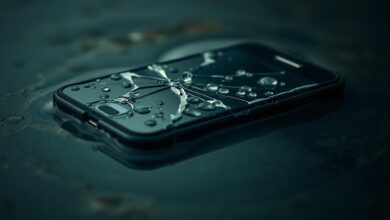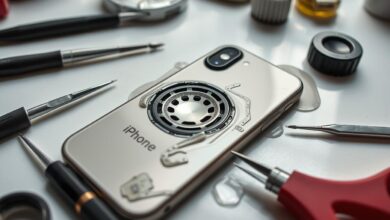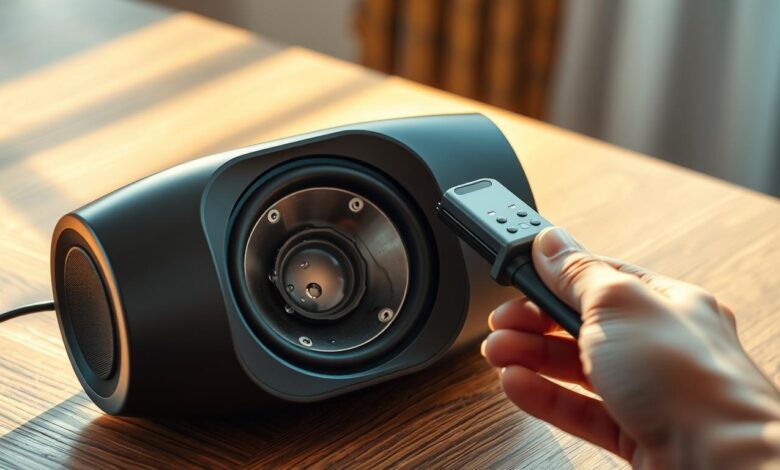
Dealing with water damage in your speaker can be really frustrating. But, there are ways to save your device. I’ll show you how to use sound waves to get water out of your speaker.
This method works by using certain sounds to push water out of the speaker. With the right approach, you can make your speaker work like new again.
I’ll explain each step clearly. You’ll learn the best sound frequency to use and how to do it safely.
Key Takeaways
- Understanding the science behind using sound waves to remove water.
- Identifying the ideal frequency for water removal.
- Step-by-step guide on applying the method.
- Precautions to avoid further damage to your speaker.
- Restoring your speaker’s functionality.
Understanding Speaker Water Damage
It’s key to know how water harms speakers for good repair and upkeep. Water damage can show up in many ways, hitting different parts of the speaker.
How Water Affects Speaker Components
Water can really mess with speaker parts, causing a bunch of problems. The damage might happen right away or later, based on how much water it gets.
Impact on Speaker Membranes
The speaker membrane is super sensitive to water damage. Water can make it brittle or break it down, messing with sound quality. Long-term exposure can cause permanent harm, so it’s vital to fix it fast.
Electronic Component Damage
Water can also ruin electronic parts like circuits and wiring, causing short circuits or total failure. Fixing this can be tough and might need a pro.
Common Ways Speakers Get Water Damage
Speakers can get water damage in many ways. Knowing these common causes helps in preventing problems.
Accidental Spills and Submersion
Spills or being submerged are big reasons for water damage. Dropping a speaker in water or spilling something on it can cause quick damage.
Humidity and Condensation Issues
High humidity and condensation can also lead to water damage over time. Speakers in humid places or with big temperature changes are at risk.
As Tom’s Hardware says, “Water and electronics don’t mix.” Good speaker maintenance means keeping it dry and fixing any damage quickly to avoid more problems.
The Science Behind Using Sound to Remove Water
Using sound to dry out waterlogged speakers works by understanding how sound waves and water interact. Water can damage speakers and affect sound quality. This method uses physics and acoustics to remove water.
How Sound Waves Interact with Water
Sound waves work with water in two main ways: vibration and breaking surface tension. Sound waves make water molecules vibrate. This helps to remove water from the speaker’s parts.
Vibration Principles
Vibration principle is about sound waves making objects move. When applied to water in a speaker, it loosens and removes the water. This works best when the sound wave’s frequency matches the water’s natural frequency.
Surface Tension Disruption
Water’s surface tension acts like an “elastic skin.” Sound waves can break this tension, making it easier to remove water. This disruption helps to eject water droplets.
Why Specific Frequencies Work Best
Certain frequencies are better at removing water from speakers. This is because of resonance and the size of water droplets.
Resonance Frequency Explained
The resonance frequency is when a system vibrates most efficiently. For water in a speaker, this is in the range of sound we can hear. Sound waves at or near this frequency make water droplets vibrate strongly, helping to remove them.
Water Droplet Size Considerations
The size of water droplets affects the best frequency for removal. Larger droplets need lower frequencies, while smaller ones need higher ones. Knowing the typical droplet size helps choose the right frequency.
For more info on removing water from phone speakers, check this resource. It offers more insights and methods.
| Frequency Range | Effectiveness | Application |
|---|---|---|
| Low Frequency (<100 Hz) | Moderate | Larger water droplets |
| Mid Frequency (100-500 Hz) | High | Typical water droplet sizes in speakers |
| High Frequency (>500 Hz) | Low to Moderate | Smaller water droplets or fine mist |
Understanding sound waves and water interaction helps maintain speakers. Regular speaker maintenance tips, like using sound waves, can keep speakers working well. This extends their life and ensures they perform at their best.
Sound to Get Water Out of Speaker: The Ideal Frequency
Finding the right sound frequency is crucial to get water out of speakers. We need to know how different sounds interact with water and affect the speaker parts.
The 165Hz Frequency Explained
The 165Hz frequency is known for its water-removing power. Let’s explore why this frequency works well and how it stacks up against others.
Scientific Basis for This Frequency
The 165Hz frequency is thought to be effective because it creates strong vibrations. These vibrations help push water out of speaker parts.
How It Compares to Other Frequencies
Studies show that 165Hz is better than 20Hz or 1000Hz for removing water. For more details, check out this page for insights on frequency effectiveness.
Why This Frequency Is Most Effective
Several reasons make 165Hz a top choice for water removal. We’ll look at research, testing, and device-specific factors.
Research and Testing Results
Research proves 165Hz is better at removing water than other frequencies. Key points include:
- Higher success rate in removing water from speaker grills.
- Less damage to speaker components compared to higher frequencies.
- Effective across various speaker types.
Device-Specific Considerations
While 165Hz is generally effective, specific factors like speaker design and water amount matter. It’s important to think about these when using this method.
Tools and Resources You’ll Need
To remove water from your speaker, you need the right tools. The process uses specific sound frequencies. Having the correct tools is crucial for success.
Smartphone Apps for Water Removal
Smartphone apps are a convenient way to create needed sound frequencies. They produce tones that help remove water from speakers.
Top Apps for iOS Devices
iPhone users should check out Sound Frequency and Water Out. These apps are top-rated and provide the right frequencies for water removal.
Top Apps for Android Devices
Android users can use Frequency Sound Generator and Water Removal Sound. These apps offer various frequencies and are easy to use.
Online Resources and Sound Files
Online resources and sound files can also help remove water from speakers. They can be accessed from any device with internet.
Reliable Websites with Water Removal Tones
Visit YouTube and sound frequency websites for water removal tones. It’s important to choose reliable sources for effective sound.
Creating Your Own Water Removal Sound
For tech-savvy people, making your own water removal sound file is an option. Use audio editing software to customize the frequency and tone.
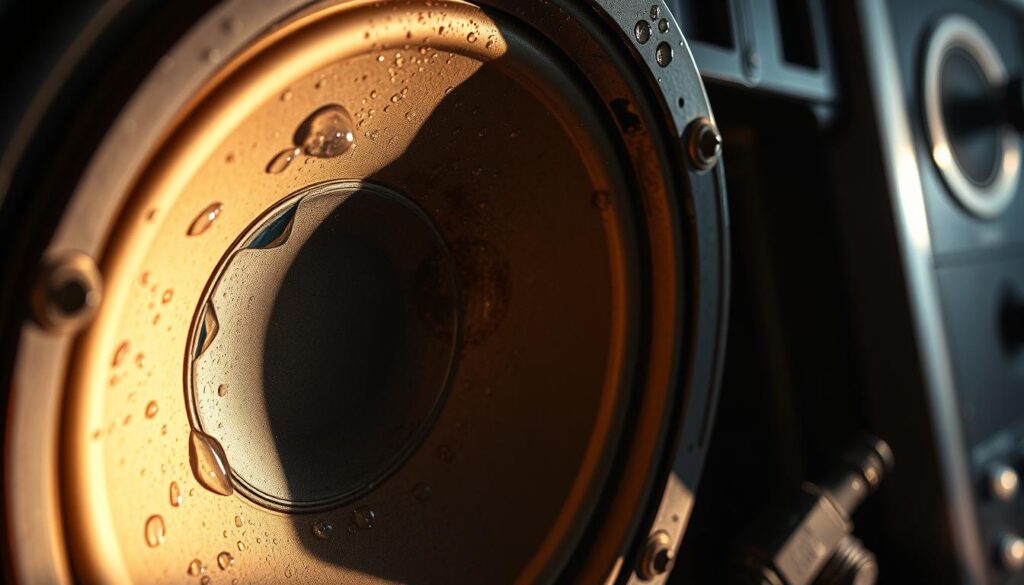
Step-by-Step Guide to Water Removal
If your speaker got wet, don’t worry. Follow this guide to remove the water. It’s important to do it right to get your speaker working again.
Preparing Your Device
Initial Assessment and Safety Precautions
First, check how wet your speaker is and take safety steps. Turn it off to avoid damage. Then, use a soft cloth to wipe off any water you see. Don’t press too hard on the speaker grills to avoid pushing water inside.
Positioning for Optimal Water Drainage
Place your speaker so gravity helps drain the water. If water got in through the grill, turn it upside down. This makes it easier to get the water out. For more tips, check out wikiHow.
Playing the Water-Removing Sound
When playing the sound, set the volume right. It should be loud enough to work but not too loud to harm your speaker. Start with the volume at about 80% of the max.
Monitoring the Process
Watch your speaker as you play the sound. You might hear water moving or see it dripping. Adjust the volume or sound as needed to help.
How Long to Play the Sound
Timeframes for Different Devices
The time needed to play the sound varies. Usually, 5-10 minutes is enough. But for serious damage, you might need to do it more times.
Signs That Water Has Been Removed
You’ll know water is gone when your speaker sounds better or you don’t see water anymore. If it still doesn’t work, you might need to try other drying methods or get help from a pro.
By following these steps, you can fix your speaker. Remember, regular speaker maintenance helps avoid water damage. For more tips, look into removing water from speakers.
Different Methods for Various Speaker Types
Fixing water damage on speakers isn’t the same for all. Each type needs its own special care. What works for a phone might not work for a fancy sound system or a smart home device.
Smartphone Speakers
Removing water from phone speakers can differ between iPhones and Androids. This is because of their design and where the speakers are placed.
iPhone-Specific Techniques
iPhone users can use a built-in feature to get rid of water. Newer iPhones can use sound frequencies to eject water. Older iPhones can use the 165Hz frequency to help remove water.
Android-Specific Techniques
Android users might need to download apps that make the right sounds. Some Androids have features like iPhones, but it depends on the maker.
Bluetooth and Portable Speakers
Speakers like JBL and Bose have unique designs. Knowing how they’re made helps in removing water.
JBL and Bose Speaker Solutions
For JBL and Bose, the 165Hz frequency might help. But, check if they have a special feature or app for water removal.
Waterproof Speaker Considerations
Even waterproof speakers can get water inside. Shaking and drying might work better than sound methods.
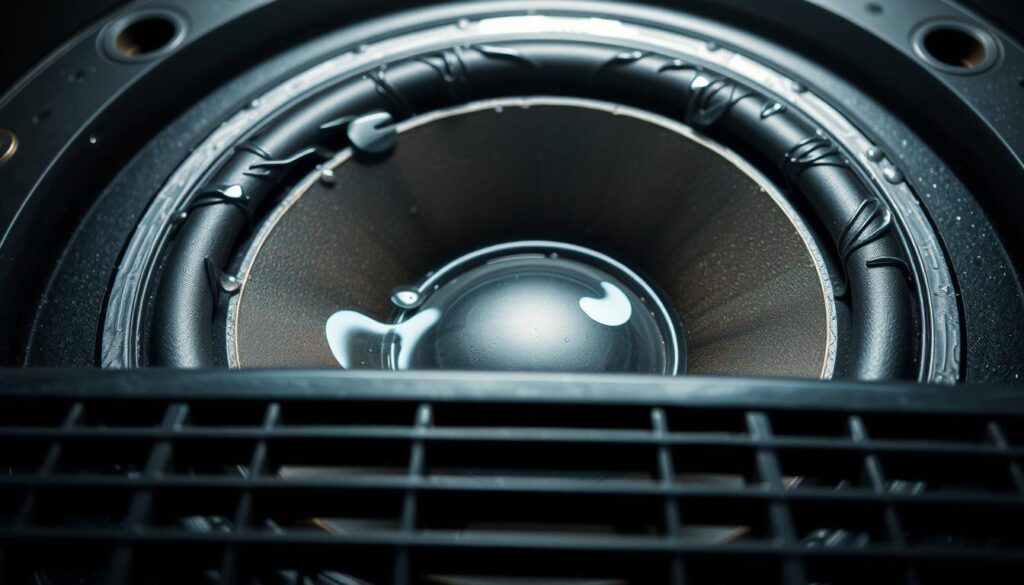
Smart Home Devices
Wet smart home devices like Amazon Echo and Google Home need careful handling. Sound methods can be risky, so follow the maker’s advice.
Amazon Echo and Google Home Approaches
For Amazon Echo and Google Home, first check the maker’s instructions. Sometimes, a soft cloth and air drying are best.
Recovery Success Rates
Getting smart home devices to work again can be tough. It’s harder than fixing phones because of their complex parts.
High-End Audio Equipment
High-end audio gear needs extra care because of its complexity and value. Getting a pro to fix it is usually the best choice.
Special Considerations for Expensive Gear
For pricey audio equipment, sound methods are not recommended. Instead, seek professional help to avoid more damage.
Professional Assistance Options
| Service | Description | Cost Range |
|---|---|---|
| Diagnostic Service | Assessment of water damage | $50-$100 |
| Repair Service | Fixing water-damaged components | $100-$500 |
| Component Replacement | Replacing damaged parts | $50-$200 per part |
Knowing what kind of speaker you have is key to fixing water damage. Whether it’s a phone, a portable speaker, or high-end audio, the right method is crucial. It can make a big difference in getting your device working again.
What to Do If the Sound Method Doesn’t Work
If the sound method doesn’t work, don’t worry. There are other ways to fix your speaker. The sound method works for many, but not all. If it doesn’t work for you, try other fixing water damage in speakers methods.
Alternative Drying Methods
Try different drying methods if the sound method doesn’t work. Using desiccants is a good option.
Rice Method: Fact vs. Fiction
The rice method is a popular DIY fix. It involves putting your device in uncooked rice to soak up moisture. But, it’s not always effective. Rice might not dry your speaker completely, and rice dust can harm your device.
Silica Gel and Desiccants
Silica gel packets or other desiccants are better choices. They’re made to soak up moisture. Putting your device near silica gel can dry it out better than rice. Silica gel is more effective at drying.
When to Seek Professional Help
At times, your speaker might not work even after trying to dry it. Know when to get speaker water damage repair from a pro.
Signs of Serious Water Damage
Look out for serious damage signs. Corrosion, constant distortion, or not working at all are bad signs. If you see these, DIY fixes won’t work.
Finding Qualified Repair Services
To find a good repair service, look for experts in fixing water damage in speakers. Check reviews and ask for recommendations. Make sure they know how to fix your device. A pro can figure out the best fix, whether it’s repair or replacement.
Preventing Future Water Damage
Protecting your speaker from water is key to its longevity. It’s better to prevent water damage than to fix it. There are many ways to keep your device safe.
Waterproof Cases and Covers
Getting a waterproof case or cover is a smart move. These items act as a shield against water, lowering the chance of damage.
Top-Rated Protection Options
Many waterproof cases and covers are out there, from affordable to high-end. Brands like LifeProof and Catalyst are known for their quality and protection.
| Brand | Product | Rating |
|---|---|---|
| LifeProof | FRĒ SERIES | 4.5/5 |
| Catalyst | Waterproof Case | 4.7/5 |
DIY Waterproofing Solutions
For a budget-friendly option, try DIY waterproofing. You can use a waterproof coating or a pouch. But, they might not be as effective as store-bought products.
Best Practices for Speaker Use Around Water
Using protective gear is just part of the solution. Safe practices when using your speaker near water are also crucial.
Bathroom and Kitchen Safety
In the bathroom or kitchen, keep your speaker dry. Don’t place it near sinks, showers, or bathtubs. Be cautious with your speaker’s placement to avoid water damage.
Outdoor and Beach Considerations
When outdoors or at the beach, watch your surroundings. Stay away from water and consider the weather, like sand and humidity, which can harm your speaker.
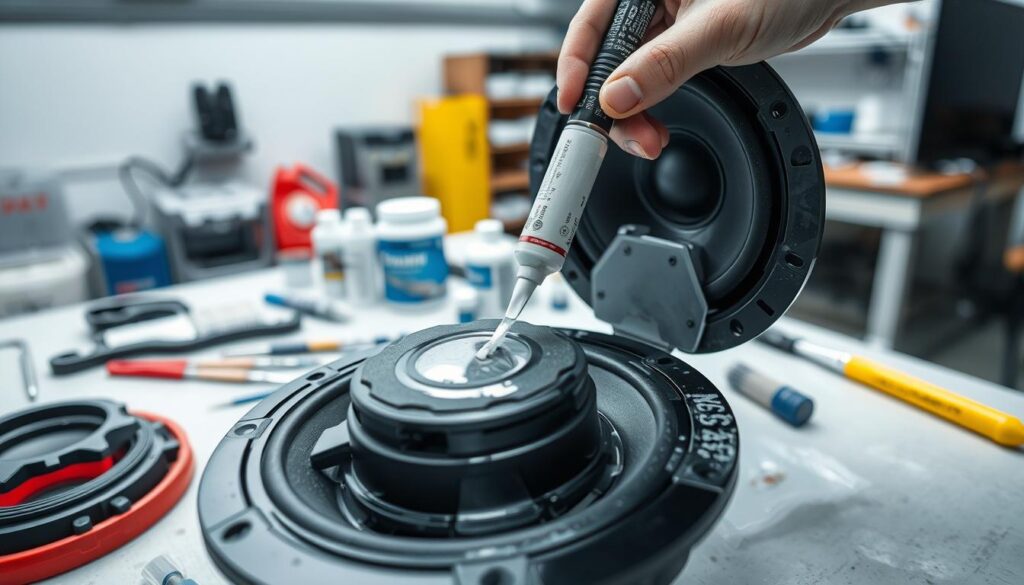
By using protective gear and practicing safe use, you can make your speaker last longer. Enjoy your music, even in wet conditions.
Common Mistakes to Avoid
Removing water from speakers is a delicate task. Some mistakes can cause permanent damage. It’s important to know the common pitfalls to avoid.
Harmful Drying Techniques
Some drying methods can harm your speaker more than help. Using heat or compressed air can push water deeper or damage electronics.
Heat Sources and Their Dangers
Heat might seem like a good way to dry out a wet speaker. But it can warp parts, damage the voice coil, or melt components. Instead, use gentler methods.
Compressed Air Risks
Compressed air is another common mistake. It can dislodge parts or push water deeper, making the problem worse. For safe drying tips, check out this guide on iPhone speakers.
Misconceptions About Water Damage Repair
Many people have wrong ideas about fixing water damage in speakers. Some think certain methods or products can fix it instantly. But these ideas often lack scientific proof.
Debunking Popular Myths
One myth is using household items to dry out a wet speaker. But these methods are often untested and can harm your speaker. Always choose scientifically-backed approaches.
Scientific Approaches vs. Internet Advice
For water damage repair, stick to methods proven by science. This might include using specific sound frequencies or other tested techniques. Using verified methods increases your speaker’s chances of being fixed.
Real-Life Success Stories
Many people have saved their water-damaged speakers with sound waves. Their stories offer hope and show how sound can work. It’s a powerful tool for fixing water damage.
Smartphone Recovery Experiences
Smartphone users have saved their devices with sound waves. Drops in bathtubs or splashes have been fixed. It’s a lifesaver for many.
Everyday Accidents and Solutions
Imagine dropping your phone in a sink. Quick sound waves can save it. It’s a fast fix for many accidents.
Phones caught in the rain can also be saved. Sound waves push out the water, making them work again.
Extreme Water Exposure Cases
Some phones have been underwater for a long time. Sound waves have saved them, but success varies.
Saving Expensive Audio Equipment
The sound method works on expensive audio gear too. It’s saved high-end equipment, saving money and time.
Professional Studio Equipment Recovery
Professional studios have used sound to fix their equipment. It cuts down on repair costs and keeps them working.
Home Theater System Rescues
Homeowners have also saved their systems with sound waves. It’s helped against accidents or floods.
| Equipment Type | Water Exposure Scenario | Recovery Success |
|---|---|---|
| Smartphone | Accidental drop into water | High |
| Home Theater System | Basement flooding | Moderate |
| Professional Studio Equipment | Spill or accidental submersion | High |
The Science of Speaker Waterproofing
Exploring the science of speaker waterproofing shows us the tech that keeps our devices safe from water. Knowing these technologies is key for keeping speakers in good shape and avoiding costly repairs.
IP Ratings Explained
The IP rating system is key in figuring out a speaker’s water resistance. IP stands for Ingress Protection, showing how well a device guards against solids and water.
IP ratings have two numbers. The first number shows protection against solids, and the second against liquids. For example, an IP67 speaker is dustproof and can handle being underwater up to 1 meter for 30 minutes.
Understanding IP67 vs. IP68
IP67 and IP68 differ in how deep they can handle water. IP67 can go up to 1 meter deep, while IP68 can go deeper, often up to 2 meters or more, depending on the maker.
What Manufacturers Don’t Tell You
It’s important to remember that IP ratings are for still conditions. Real-life situations, like moving or being underwater for a long time, can change how well a device stays dry.
How Waterproof Speakers Work
Waterproof speakers use special tech to keep water out. They use membrane and seal technologies.
Membrane and Seal Technologies
Membrane tech uses a waterproof but breathable membrane. It lets sound through but keeps water out. Seal tech seals the speaker parts to block water entry.
Limitations of Waterproof Designs
Even waterproof speakers can’t handle everything. Damage from wear and tear, misuse, or going beyond the rated limits can still cause harm.
When to Replace vs. When to Repair
When a speaker gets waterlogged, deciding whether to fix it or replace it is tough. This choice depends on how bad the damage is, the repair cost, and the speaker’s condition.
Assessing Permanent Damage
To figure out if a water-damaged speaker can be fixed, you need to check the damage. This means a detailed look and test of how well the speaker works.
Visual Inspection Techniques
Looking at the speaker can show signs of water damage. Check for corrosion on the circuit board or damage to the speaker cones. Look for any signs of moisture or mineral deposits.
Key areas to inspect include:
- The speaker grille and surrounding areas for signs of water ingress
- The circuit board for corrosion or mineral deposits
- The speaker cones for tears or other damage
Performance Testing After Water Exposure
After checking visually, test the speaker’s sound. Play different sounds to see if there’s distortion or if the sound is weak.
Performance testing can help identify:
- Distortion or crackling sounds indicative of damaged speaker components
- Complete loss of sound in one or more speakers
Cost-Benefit Analysis of Repair vs. Replacement
Choosing to fix or replace a water-damaged speaker also depends on cost. Compare the repair cost to buying a new speaker.
Repair Cost Considerations
When thinking about fixing, consider the cost of parts, labor, and any extra services needed to fix the speaker.
When New Technology Makes More Sense
If the repair cost is almost as much as a new speaker, especially for an old one, getting new tech might be better.
| Consideration | Repair | Replace |
|---|---|---|
| Cost | Parts and labor costs | Cost of a new speaker |
| Technology | Retains existing technology | Access to newer, potentially improved technology |
| Warranty | Typically, no warranty on repairs | New speaker usually comes with a warranty |
Conclusion
Using sound to remove water from speakers is a good method. It works well if you do it right. Knowing how to use the right frequency, like 165Hz, can save your speaker.
To keep your speaker in good shape, follow some important tips. Use waterproof cases and covers. Also, be careful when using your speaker near water. Regular care helps avoid water damage and keeps your speaker working well.
Being informed and ready can help protect your speaker. This is true for any speaker, from smartphones to high-end audio gear. Using sound to remove water can be a simple and effective fix.
FAQ
What is the best sound frequency to get water out of a speaker?
The 165Hz frequency is often cited as one of the most effective frequencies for removing water from speakers. It resonates with water droplets and disrupts their surface tension.
Can I use any smartphone app to remove water from my speaker?
While there are several smartphone apps designed for water removal, their effectiveness can vary. It’s essential to choose an app that generates the 165Hz frequency or allows you to upload a custom sound file with this frequency.
How long should I play the water-removing sound to dry my speaker?
The duration for playing the water-removing sound can vary. Start with shorter intervals (around 5-10 minutes) and check the speaker’s condition.
Will using sound to remove water from my speaker damage it further?
When done correctly, using sound to remove water is a safe method. However, it’s crucial to keep the volume at a reasonable level to avoid causing additional damage to the speaker.
Are there any alternative methods to remove water from speakers if the sound method doesn’t work?
Yes, alternative drying methods include using silica gel or desiccants. If these methods fail, it may be necessary to seek professional help, especially if you suspect serious water damage.
How can I prevent water damage to my speaker in the future?
Using waterproof cases or covers, being cautious when using your speaker near water, and following best practices for speaker maintenance can significantly reduce the risk of water damage.
What are the signs that my speaker has suffered permanent damage from water exposure?
Signs of permanent damage include distorted sound, reduced volume, or complete failure to produce sound. A visual inspection may also reveal corrosion or mineral deposits on the speaker components.
Is it worth repairing a water-damaged speaker, or should I replace it?
The decision to repair or replace depends on the extent of the damage and the cost of repair. For high-end or sentimental speakers, repair might be the preferred option, while for cheaper models, replacement might be more cost-effective.
Can I use the sound method to remove water from any type of speaker?
The sound method can be applied to various speaker types, including smartphone speakers, Bluetooth speakers, and some smart home devices. However, the effectiveness may vary depending on the speaker design and the extent of water exposure.
What are some common mistakes to avoid when trying to dry a water-damaged speaker?
Avoid using heat sources like hair dryers, as they can cause further damage. Also, be cautious with compressed air, as it can push water further into the speaker. Relying on unverified internet advice rather than scientific approaches can also lead to ineffective or harmful drying methods.

